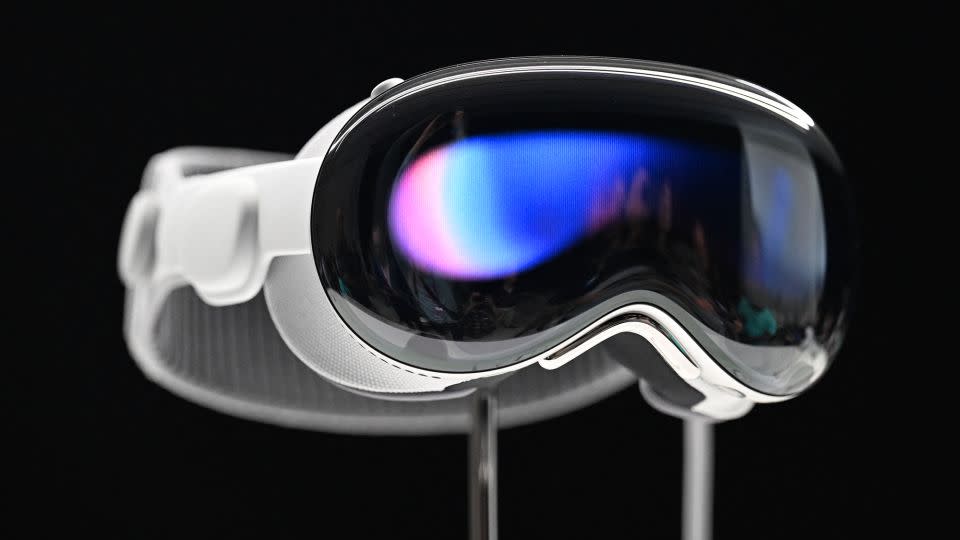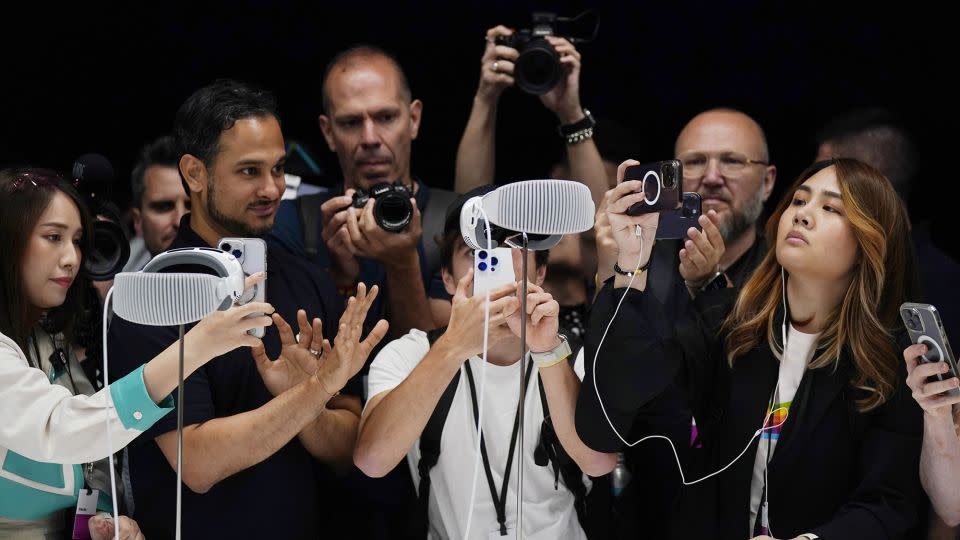Tim Cook is risking his legacy on a pricey product in an unproven market
At a demo hall inside Apple’s headquarters after he unveiled the Vision Pro mixed reality headset in June, CEO Tim Cook smiled for pictures as he stood near the company’s newest product, taking one of 2023’s biggest risks.
Apple kept the Vision Pro mostly out of onlookers’ hands that day. Only in a few private briefings did reporters get a chance to try it out, highlighting the fact that the Vision Pro is still very much a work in progress. (Even now, it’s reportedly undergoing design changes to make it lighter and more comfortable ahead of its official launch next year).
The Vision Pro will be Apple’s riskiest product launch in years, which is why Tim Cook is one of CNN Business’ Risk Takers for 2023. Cook has long talked up the potential for augmented reality to help people communicate and collaborate. Now he will have to prove a device that blends both virtual reality and augmented reality, a technology that overlays virtual images on live video of the real world, is indeed the future of computing. And it won’t be an easy sell: It’s a $3,499 clunky computer you wear on your face.
It’s also Cook’s first new major hardware product in 7 years and only the third in his tenure as CEO since Apple co-founder Steve Jobs died.

The headset will come at a time when the extended reality (XR) market – a category that includes augmented, virtual and mixed reality – has plateaued with little mainstream consumer adoption. The Vision Pro will also have limited apps and experiences out of the gate and will be tethered to a battery pack the size of an iPhone.
But Jeremy Bailenson, founding director of Stanford University’s Virtual Human Interaction Lab, said companies like Apple are betting customers will eventually use virtual headsets for just about everything. “Let’s use the medium, but when it earns its keep,” he said. “Betting on VR to be the new smartphone is risky.”
Despite running a company worth $3 trillion, with hundreds of hundreds of billions of dollars of cash on hand, a lot is at stake for Cook. Tech companies don’t typically last for long atop the industry, as exciting and new technology takes the world by storm and ultimately dethrones the leader. (See: HP, IBM, Cisco … and what Apple did to Microsoft).
IPhone sales aren’t surging anymore. Eventually, Cook & Co. will need something to replace it. But skeptics aren’t sure Vision Pro is it: The device is entering an uncertain market while facing design complexities and high costs.
At the same time, the potential is massive. Almost every new Apple product promises to use screens of varying sizes to change how we live. The Vision Pro has the potential to do all of that in an even more striking way, and it could bring new interest to the market in ways similar to what the iPod did for music players or the iPhone for smartphones.
It could also end up being the product that defines Cook’s legacy.
Risk is in Apple’s DNA
If Tim Cook retired today, he would go down as one of the decade’s most successful CEOs. Under his leadership, Apple’s market cap has grown 700%, its iPhone business remains strong, and he has built a robust services business, with music, TV and gaming products, to bring in revenue untied to hardware sales. He also introduced the wildly successful Apple Watch and AirPods.
Cook is best known for his operations expertise, rather than being a product visionary, but in the 12 years leading Apple since co-founder Steve Jobs’ death, he has certainly taken product risks. There have been major missteps under his tenure too, such as the disastrous introduction of Apple Maps, “Batterygate,” allegations of poor labor conditions at its suppliers’ factories and criticism for giving too much deference to the government of China, one of its most important and fastest-growing markets.
But now Cook wants to add to his legacy the one thing he hasn’t done yet that Jobs did routinely: launch a truly breakthrough hardware product.
Tim Bajarin, a longtime Apple analyst and president of consumer tech research firm Creative Strategies, acknowledged taking risks has always been a big part of the company’s ethos. Jobs, for example, famously changed the way the personal computer looked first with the candy-colored iMacs in 1999, and later with the iPod and iPhone. (Cook joined Apple in 1998 as an executive VP for worldwide sales and operations).
“That whole time, Cook was Steve’s right hand man of executing these visions,” Bajarin told CNN. “I think it instilled into him the concept that you are not going to break new grounds unless you innovate.”
In recent years, Apple has embraced a “not first but best” mantra, taking its time to develop new products before rushing them to market. At the company’s 2017 Worldwide Developer Conference, the company laid the foundation for the Vision Pro by launching a framework called ARKit that would let developers build augmented reality into apps. It demonstrated how people could do varying tasks such as placing furniture in their home before making a purchase and put a spotlight on its usage potential inside video games, education – such as allowing students to practice surgeries – and sports, in the years to come.
In many ways, the Vision Pro is better set up for success on day one than previous products, such as the iPod or iPhone, which didn’t have an iTunes Store or App Store, respectively, on launch day.
“They’re coming out the door with already hundreds of thousands of developers who can develop for the Vision Pro from the beginning,” Bajarin said.
But the technology – and demand for it – remain unproven. While Apple has been working behind closed doors on Vision Pro for years, other companies’ headsets have seen only limited uptake, according to Eric Abbruzzese, a director at ABI Research. For example, Meta’s Quest 2 is the most successful headset by “a significant margin” — about 20 million units shipped in its lifetime, he said. In comparison, the iPad line has averaged between 10 million and 15 million shipments each quarter for years. (The Apple Watch does similar numbers).
“Vision Pro is perhaps most comparable to the iPhone launch — competition existed, and Apple knew the first generation was not going to be a smashing success, but the roadmap for the device improving over time and becoming more accessible was the ultimate goal,” Abbruzzese said. “Vision Pro will not shift millions of units, but it has the potential to define the product category (mixed reality headsets) for the market.”
The Apple touch
Although Cook has praised the power of virtual and augmented reality for years – “we are high on AR in the long run,” he said on a 2016 earnings call – he’s also been critical of its execution. Cook previously called virtual reality “really cool” but said last year it’s better for periods of time and “not a way to communicate well.” Apple’s approach with the Vision Pro aims instead to allow users to communicate and be productive while experiencing immersive worlds.

A common praise from people (including this reporter) who have tried Vision Pro: It is easy to imagine using Vision Pro for watching movies and TV. Apple will likely get buy-in from Hollywood filmmakers to create experiences just for the headset stemming from the company’s close relationships in the entertainment industry, including with former Apple board member and Disney CEO Bob Iger. (Iger announced during the event that Disney+ will be available on the headset at launch). NBA Commissioner Adam Silver recently said it is working closely with Apple to bring a tech-enhanced viewing experience to the Vision Pro, too.
But it was harder to imagine looking at photos, texting or doing a search on Safari while wearing the headset. Bailenson, the founding director of Stanford University’s Virtual Human Interaction Lab, believes virtual headsets are a powerful medium but only for certain experiences, and for about 30 minutes at a time. That’s because the human perceptual system gets fatigued due to how different virtual displays are from the real world, he said.
“Through hundreds of studies, we have learned it is best to save VR for experiences that in the real world would be dangerous, impossible, counterproductive or expensive,” Bailenson said.
This includes, for example, training firefighters, rehabilitating stroke victims or practicing difficult conversations in the workplace. “[Not] checking your email, watching movies and general office work… .”
It’s also an issue of user comfortability and aesthetics, no matter how well designed a headset may be. Let’s recall how Oculus founder Palmer Lucky was meme-ified years ago after he wore a headset on the cover of Time magazine; similarly, a picture of Meta CEO Mark Zuckerberg walking next to a group of people wearing headsets during a tech event was ridiculed for being “dystopian” and “creepy.” As Phillip Shoemaker, a former executive for the Apple App store, put it in a tweet following the Vision Pro announcement. “Nobody looks good wearing a headset. We all look like big nerds.”
Some believed the pitch for the Apple’s headset felt mistimed, too. Earlier in the pandemic, more people might have jumped at the chance to create these virtual experiences while we worked and socialized almost entirely from home. Now, with more employees back in the office and companies looking to cut costs amid broader economic uncertainty, the justification for the pricey device seems less clear.
But Abbruzzese argues perhaps the timing might be right on schedule, calling the years of hiring, research development and related acquisitions a “boon” for the company. Still, even with a loyal following and impressive track record on hardware, it may be hard to convince developers, early adopters and some enterprise customers to pay up for the device.
“If Vision Pro does end up defining the mixed reality space, then that would be like the iPhone launch in some ways — not an immediate win, but a multi-year strategy that changed phones forever,” he said.
If it falls short of expectations, it could be spun as an innovative idea the market wasn’t ready for, he added. “There may be a rough quarter or two with shareholders showing their disappointment, but the company has so many more successes in the portfolio that will not last long.”
But Cook would still be without his defining product.
For more CNN news and newsletters create an account at CNN.com
